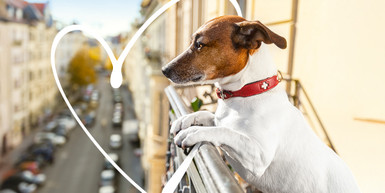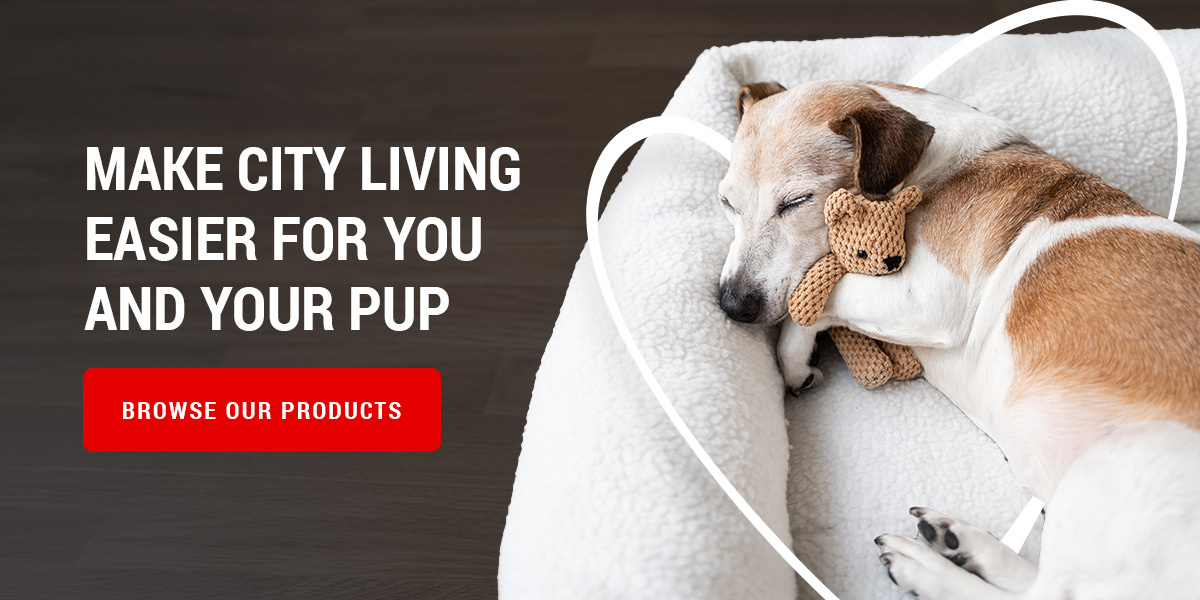Urban Dog Living: Tips for City Dwellers
You've made the decision to get a dog, but perhaps you have concerns about training and nurturing them in a confined apartment space or a busy city setting. With the dense traffic and lack of open fields, how do you give your dog the best care and quality of life possible?
Owning a pet in the city is easier when you understand how to prepare for the unique challenges of urban living. Explore practical advice, tips and solutions for raising a dog in a small space or city environment.
The Challenges of Raising a Puppy in the City
Cities bring a few roadblocks — both literally and figuratively — that can interfere with daily dog training, so you may have to alter your lifestyle and routine accordingly. Some challenges associated with urban dog living include:
- Space limitations: Apartments usually have less square footage than traditional homes, meaning less indoor space for play and exercise. There may also be limited outdoor green space surrounding the apartment complex, if any at all.
- Noise concerns: Sound carries more in apartment buildings since the units are compact and close together. As such, you'll have to be more mindful about squeaky toys, barking and other sounds that could disturb your neighbors.
- Additional costs: Most landlords charge extra for tenants with pets, whether as a one-time fee, a monthly rent payment or a security deposit. These fees can vary depending on the location and the landlord's policies. You may also be restricted to certain dog breeds and sizes, depending on your apartment building's policies.
The Best Dogs for City Living
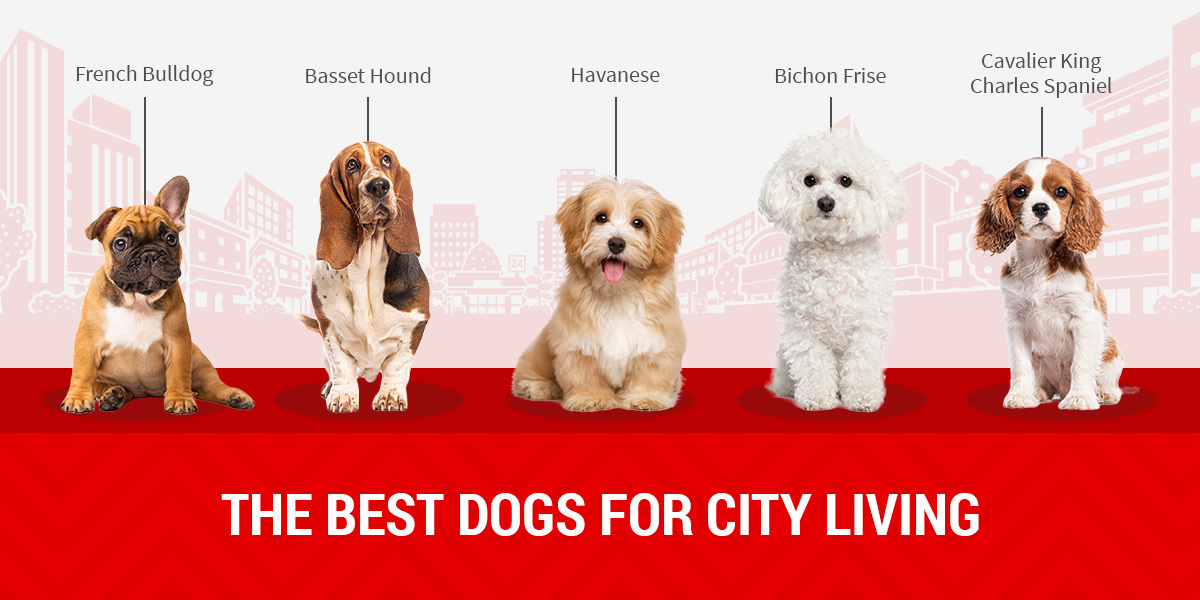
In urban environments, picking the right dog requires careful consideration, as a few factors will influence your decision. Larger or more energetic breeds — such as border collies, German shepherds, rottweilers and Siberian huskies — may not adapt well to confined apartment living since they need more space and exercise. In many rental communities, the standard weight limit for dogs is between 45 and 50 pounds. Some landlords even prohibit certain breeds entirely.
It's important to choose the most suitable breeds and temperaments for your lifestyle. According to the American Kennel Club (AKC), some of the best apartment dogs are:
French Bulldog
French bulldogs are well-suited for apartment living due to their small size, relatively low exercise needs and quiet nature. Because these dogs are often content with short walks and playtime, a lack of open space isn't normally an issue. They're also known for being social and affectionate, so they tend to get along well with other people and dogs.
- Weight: Under 28 pounds
Basset Hound
Basset hounds are known for their calm, laid-back nature, moderate exercise needs and relatively compact size. They aren't overly energetic and are avid nappers, making them excellent apartment dogs. While they should be walked regularly, a brief stroll around the block will usually suffice. Just note that basset hounds have a tendency to howl, so be wary if you have thin walls.
- Weight: 40-65 pounds
Havanese
Havanese are affectionate and loyal pals. They're easy to train and generally adapt well to various living situations, including apartments. Their small size and low exercise requirements are also ideal for apartment life. They thrive on companionship and can be happy with indoor play and short walks. As a bonus, this breed is hypoallergenic, so you're in luck if you're prone to allergy flares.
- Weight: 7-13 pounds
Bichon Frise
Provided they receive regular walks and ample attention, bichons are typically content in apartments. These small, adaptable dogs don't require large living spaces and have relatively low exercise needs. However, they should still have plenty of room to play, explore, rest and relax, as well as daily walks around the neighborhood.
- Weight: 12-18 pounds
Cavalier King Charles Spaniel
Cavalier King Charles spaniels have moderate exercise needs — while they don't require tons of space, regular walks and playtime are a must. Their affectionate, adaptable nature makes them terrific apartment dogs. Just keep in mind that these are Velcro pups, and they don't like to be left alone for long periods.
- Weight: 13-18 pounds
Creating a Pet-Friendly Home in the City: 7 Tips
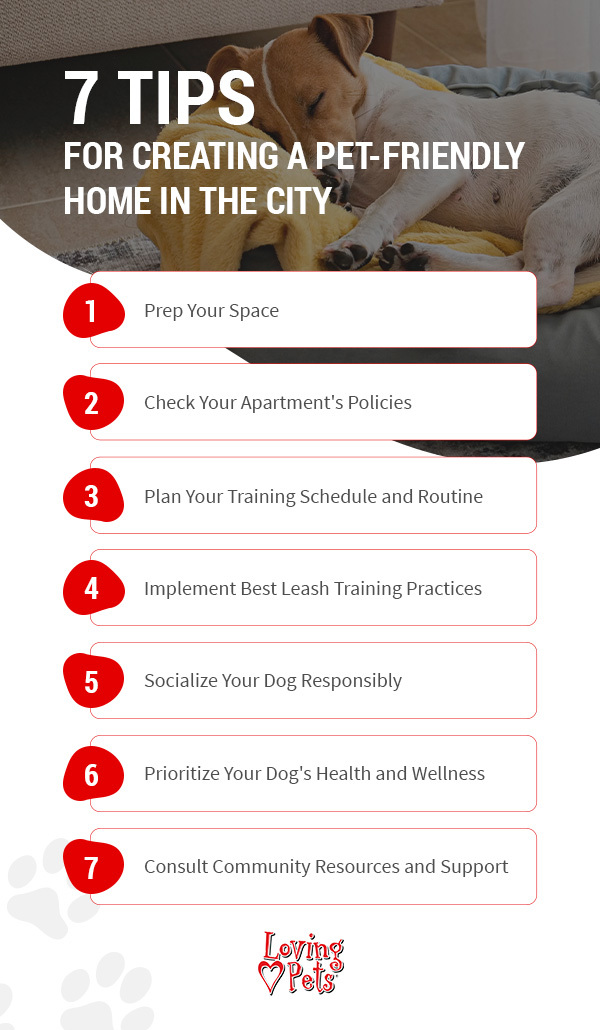
While apartment living and urban environments present unique challenges, there are plenty of ways to ensure your furry friend thrives in the city.
1. Prep Your Space
Before welcoming your new family member into your apartment, you'll want to prepare your space by::
- Grabbing the essentials: Start by shopping for basic accessories, including a collar and leash, a crate, food and water dishes, grooming supplies, training treats, toys and a comfy bed.
- Pet-proofing your apartment: Take a few proactive measures to make your apartment dog-friendly. Move shoes, sharp objects, linens, medications and other prohibited items out of your pup's reach, such as in closed closets or on high shelves. If any spaces within your apartment are off-limits to your dog, close them off with baby gates. You can also equip eating areas with spill-proof dog mats to catch scattered kibble and water, making everyday cleanup less of a hassle.
2. Check Your Apartment's Policies
Your apartment may have specific rules and guidelines regarding pets. Be sure to review them beforehand and contact your landlord with any questions if necessary. Note any required payments outlined in your lease agreement, such as:
- Pet deposit: A security deposit — generally refundable — that's specific to pet damage
- Pet fees: One-time, nonrefundable fees used to cover pet-related damage during the rental period, like stained carpets or scratched floors
- Pet rent: A monthly recurring fee to help offset some of the costs of potential pet-related damage
3. Plan Your Training Schedule and Routine
Because you're living in a shared building with space and noise restrictions, you'll need to plan your training schedule to accommodate this lifestyle. This routine should factor in everything from potty training to indoor exercise and walks.
Start by scoping out nearby outdoor spaces to bring your pup — these areas can vary widely depending on your apartment complex's layout. For instance, your apartment may have just a few sparse grassy areas, which are only suitable for bringing your pup out for a quick bathroom break. In that case, you'll need to find dog-friendly parks or nearby walking trails to ensure your four-legged friend gets the physical activity they need.
On the other hand, maybe your building has a spacious fenced-in yard, paved walking trail or dedicated dog park as an amenity for its residents. Analyze the available outdoor space so you can plan your dog's bathroom breaks, socialization, walks and outdoor exercise accordingly.
Here are some other key considerations to plan for:
- Potty training: When nature calls, letting your dog out right away can be challenging in an apartment. You may have limited access to grass or longer distances to outdoor areas, which can complicate potty training. The younger the puppy, the more frequently they'll need to go out — for instance, a 2-month-old pup should typically be let out every two to three hours. Make sure you plan for frequent trips. You can also place puppy pads around the apartment, or in their crate or enclosure, in case of accidents.
- Work schedule: Unless you work from home, it can be difficult to plan your routine around your pup's needs. If you're unable to coordinate your schedule or stop at home to let your dog out during breaks, consider hiring a dog walker to handle these tasks while you're out.
- Indoor exercise: On rainy days when you can't take your pooch outdoors to play, you'll want some toys and creative activities to keep them entertained indoors. If your apartment space allows for it, you can play fetch or create a mini obstacle course. Interactive and puzzle toys are also great for mental stimulation and can keep your pup occupied when you aren't home.
4. Implement Best Leash Training Practices
Leash training in the city can be more challenging compared to quiet suburban or rural environments. Urban settings are constantly bustling with activity, from traffic and construction work to other pedestrians, which can be highly stimulating and distracting to your pup.
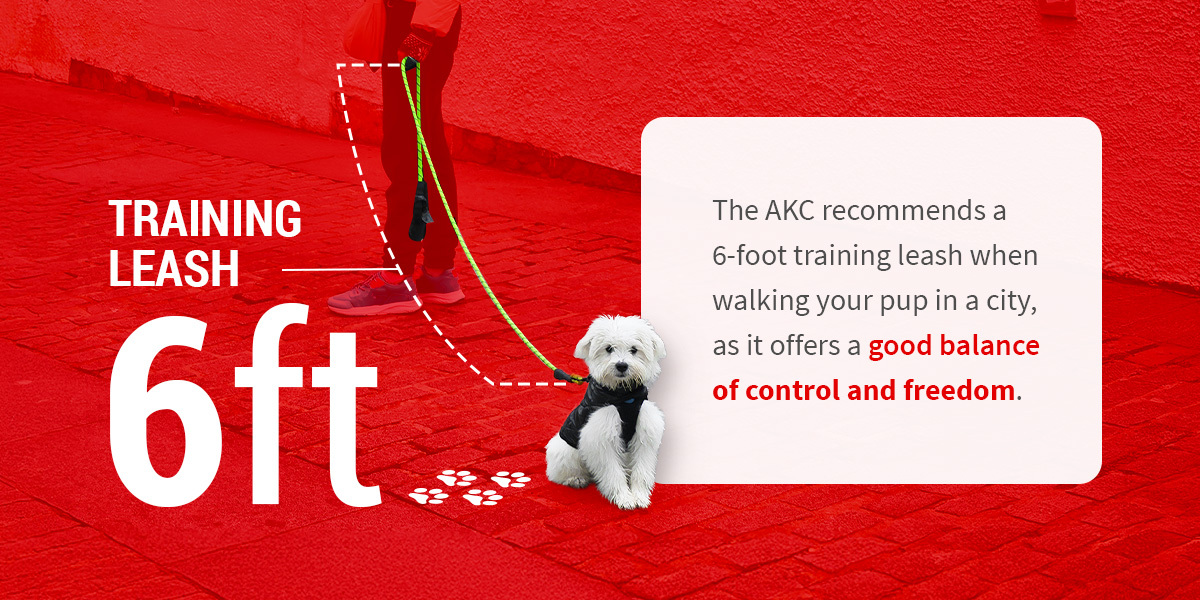
Leash training requires patience and positive reinforcement, focusing on safety, environmental awareness and proper curb etiquette. When navigating sidewalks and traffic during daily walks in urban areas, keep these helpful tips in mind:
- Use an appropriate leash length: The AKC recommends a 6-foot training leash when walking your pup in a city, as it offers a good balance of control and freedom. You can keep your dog close for safety and obedience while still allowing them plenty of space to walk and explore comfortably. Consider having your dog wear their harness and leash indoors, even while they're playing or resting, to familiarize them with the feeling of wearing them.
- Teach your dog to ignore distractions: In buzzing, vibrant city environments, your pup will need to learn how to remain calm and focused despite these distractions. Start by training in a quiet space, such as in your apartment. Gradually move up to new areas with more distractions, such as dog-friendly shopping centers or parks. This approach will help your dog build up tolerance to busy cities and maintain focus.
- Respect others: Not everyone is comfortable with being approached by a random dog. It's important to be considerate of others during walks — don't let your pup approach other people or dogs uninvited.
- Teach the “leave it” command: This cue teaches your dog to avoid approaching things they shouldn't, such as discarded food wrappers on the sidewalk, traffic or other animals. Over time, they'll learn to ignore these distractions in the city.
- Reward positive behaviors: Use training treats and verbal praise to reward your dog for practicing desired walking behaviors.
5. Socialize Your Dog Responsibly
Socialization is important for dogs. It helps them develop confidence, reduces fear and anxiety, and teaches them how to interact safely with other people and dogs.
Fenced-in dog parks are an excellent way to socialize your pup, allowing them to engage in off-leash play. Like bringing your dog on a public walking trail or sidewalk, it's essential to exercise proper etiquette at the dog park and be respectful of others. Keep the following tips in mind:
- Only remove your dog's leash once they're safely behind the locked gate.
- Never leave them unsupervised.
- Always pick up after your dog.
Note any size or weight limits for separated small and large dog park areas, as well as any vaccination requirements or age restrictions. The park may also have rules regarding dogs who aren't spayed or neutered. Female dogs in heat should avoid dog parks altogether, regardless of the individual park's regulations.
While at the park, keep a close eye on your canine and monitor their body language. If they bare their teeth at another dog or exhibit a tense, rigid posture, these could be signs of aggression. If tensions begin to rise, remove your dog from the park as quickly and calmly as possible to prevent any ugly confrontations. Call it a day if they show signs of distress or exhaustion — don't push them to keep playing.
6. Prioritize Your Dog's Health and Wellness
On top of regular walks, exercise and socialization, you can nurture your pup's health, happiness and well-being through:
- Proper nutrition: Dogs need a balanced diet of protein, minerals, vitamins, carbs, fats and water, tailored to their breed, age, health and activity level. In addition to kibble and treats with quality ingredients, you can also include whole foods like sweet potato, carrots, pumpkin, blueberries and salmon in their diet.
- Regular vet visits: Research the most reputable veterinarians in your city to ensure high-quality care for your dog. Take your pup for annual checkups to check for signs of disease and assess their overall health.
- Managing stress, anxiety and separation issues: It's not uncommon for dogs to experience separation anxiety when their humans are away. You can help prevent attachment issues in your pup by focusing on building their independence. Start with short periods of alone time, gradually increasing the duration. Make sure they are well-exercised, and create a stimulating environment with enriching activities that keep them entertained while you're away.
7. Consult Community Resources and Support
If you need some help adjusting to raising your pup in the city, don't hesitate to lean on a support network — especially if you're a first-time dog owner. Research local organizations, trainers and pet-friendly services for professional assistance. Online forums are another fantastic resource to get pointers from fellow dog owners.
If you're looking for places to bring your furry friend — whether you're traveling or exploring local spots — several resources are available. For example, BringFido is an online directory that helps you find pet-friendly hotels, restaurants and parks in the area.
Make City Living Easier for You and Your Pup
With these tips for raising a dog in the city, you and your canine companion will be well-equipped to tackle urban life together — whatever it may throw your way. Stocking up on the essential supplies is a key part of this process. Luckily, we've got you covered at Loving Pets.
Enjoy our convenient online ordering options, bundle deals and free shipping on orders over $49. We have a variety of products available, many of which are made in the USA:
- Affordable, high-quality treats, bones and chews
- Durable and stylish bowls, feeders and treat containers
- Spill-proof mats
Choose Loving Pets as your partner in urban dog living. Browse our selection of dog products online today and start shopping for your pup!

